This post comes to us courtesy of writer and Williams-Sonoma creative consultant Laura Martin Bacon.
If it’s early springtime and you can sense the sweet rhythms of sap rising, it must still be sugaring season.
A while back, I found out that one great place to savor its pleasures firsthand is Burton, Ohio – a 200-year-old village in the heart of the region’s Amish country. At first glance, the New England-style town square seems simply to be a peaceful pastoral oasis, where nothing much could happen amidst the winter’s last billowing snowdrifts.
Stately old sugar maples punctuate the village green, their leafless silhouettes etched against the dazzling blue of the morning sky. Then, a closer look reveals the sweet secret of every maple tree in town: a traditional tap and metal bucket, into which clear sap falls drop by precious drop.
If that’s not enough to convince you that sugaring season is in swing, the steamy plumes swirling from the chimneys of the Burton Log Cabin will make your sweetest dreams come true.
Situated at one end of the town square, the Log Cabin has a working sugarhouse where maple lovers can watch the magical processes of syrup production. Inside the sugarhouse, steam rises from the bubbling sap inside the evaporator — and the mouthwatering aroma of maple syrup fills the air.
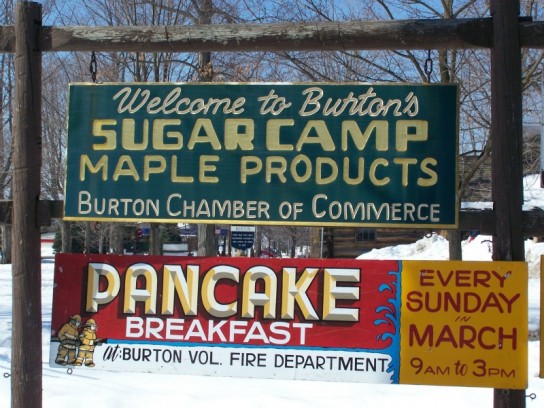
The time-honored production process is explained to me by Thad Blair, a veteran syrup maker who began learning the local sugaring traditions at the age of five.
“It all begins with the tree,” he says, going on to describe his snowy treks from one maple to the next as he gathers the sap that will be transformed into syrups and confections.
Sugaring season is defined by the whims of weather, requiring precise climatic conditions to inspire the running of the sap that will become maple syrup.
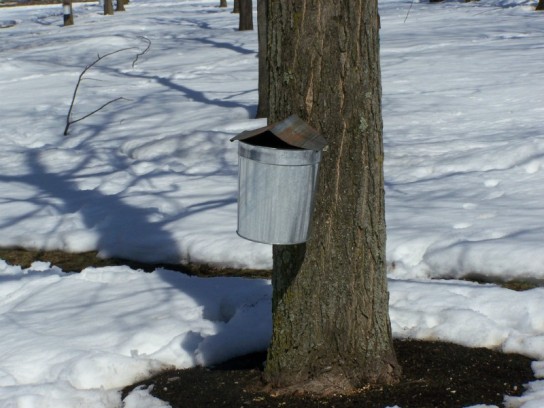
Freezing temperatures at night, followed by warmer days, drive the sucrose-rich sap from the roots of the maple tree to its branches. Harvesting occurs during the sap’s inner-tree journey via a tap carefully driven into the bark of the maple, which allows the sap to drip into a metal bucket.
Making maple syrup is a centuries-old technique that calls for carefully boiling down the season’s harvest of “sweetwater” (as it was known to Native Americans).
As the sap boils down, it thickens and takes on a distinctive amber color. It takes anywhere from 35 to 50 gallons of sap to produce a single gallon of maple syrup, with each tree’s tap hole contributing an average of around 10 gallons of sap.
Early in the season, when the weather is colder, the sap produces a sweeter, more delicate syrup. This light, mild syrup — often known as Grade A — is used on its own as a condiment and as the single ingredient in maple sugar and maple cream candy.
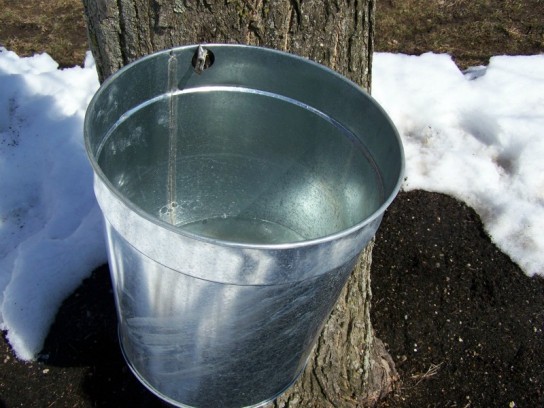
As the weather warms, the sap becomes more diluted with water and requires longer boiling, which yields a darker, more robustly flavored syrup. Prized for its intense maple flavor and rich amber hue, Grade B syrup is typically used for baking and cooking.
After being surrounded by the tantalizing scent of maple-syrup-in-the-making, visitors enjoy venturing into the sugarhouse’s adjoining sweetshop. Behind the hewn-log counters, artisan candymakers handcraft a signature version of maple cream, one of America’s oldest confections.
The pure maple syrup is heated and cooled in copper kettles, which are spun on a device that resembles an old-fashioned potter’s wheel. As the translucent amber syrup spins, the candymaker aerates it using a wooden paddle.
In just a few minutes, the contents of the kettle are transformed into fluffy, pale gold maple cream. What do connoisseurs consider the best way to enjoy this decadent candy? Observation reveals: straight from a tasting spoon!
For maple fans with a pioneer do-it-yourself attitude, the candymakers also offer kid-friendly “maple stirs.” Hot maple syrup is poured into a bowl — and when it cools down a bit, you stir it to creamy perfection with a flat wooden stick (which conveniently doubles as a serving utensil).
Maple lovers often emerge from the Log Cabin ready for even more maple syrup. If it happens to be Sunday, they can indulge their cravings at one of the many local pancake breakfasts. These legendary social events and fundraisers are held everywhere from regional high schools to volunteer fire departments, where family recipes and friendly competition are the name of the game.
Chefs-in-the-know tell me that, in addition to its tried-and-true role on the breakfast table, maple syrup can be a transformative ingredient in all sorts of recipes. (Need proof? Try a dash in your favorite vinaigrette).
One thing is certain: Pure maple syrup offers a natural taste of vintage Americana – and it’s guaranteed to make any day a lot sweeter!
Recipe: Old-Fashioned Maple Stirs
1. In a heavy saucepan, boil pure Grade A maple syrup (you decide how much!) over very low heat without stirring.
2. Wait patiently until the temperature reaches 233°F on your candy thermometer.
3. Allow the syrup to cool to 110°F (and resist the temptation to stir).
4. Pour the syrup into serving bowls, then stir until it’s light and fluffy, with a creamy pale gold color.
5. Savor the old-fashioned sweetness of homemade maple candy!
About the author: Laura is a longtime writer and creative consultant for Williams-Sonoma and other well-known entities. She’s also the Culinary Creative Director of DooF (“food” backwards), an organization that uses multi-media entertainment, education and live events to help kids and families discover the magic of food. DooF explores every aspect of food – from flavors, history, science and cultural traditions to the exciting journey from source-to-table. Laura’s mission: to make good food fun – at home, in the classroom and beyond.

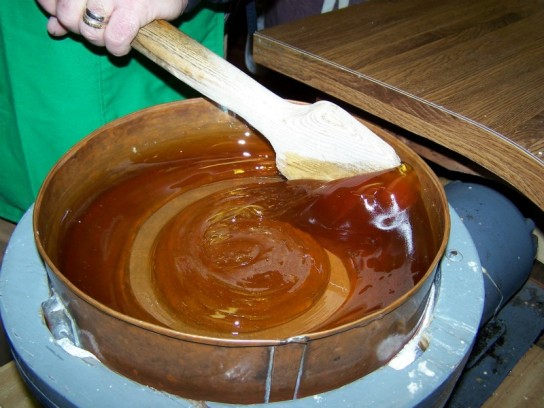
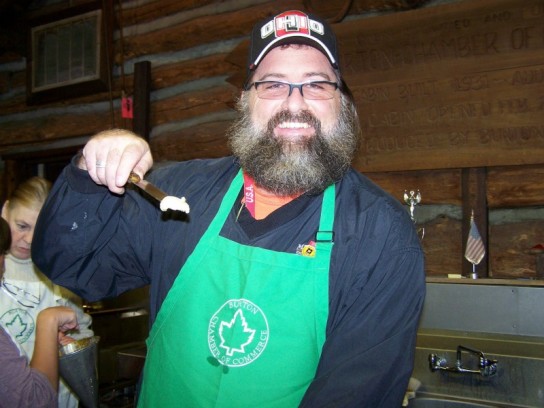
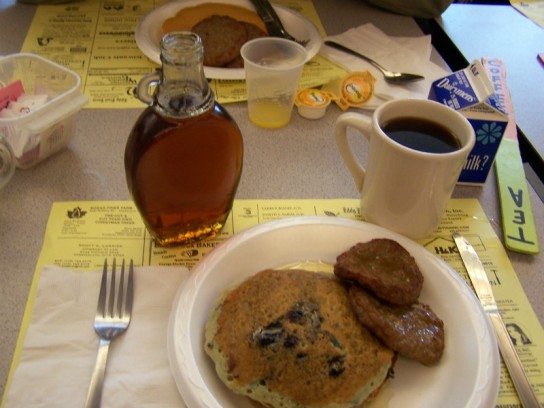
9 comments
Every ωeekend i used too go to see this website,
for the reason that i want enjoyment, as this this site conations truly nice funny stuff too.
Hey There. I found your blog using msn. This is
a really well written article. I will make sure
to bookmark it and return to read more of your useful information.
Thanks for the post. I will definitely return.
Especially you should carefully remove all makeup off the eyes.
One of the most common causes of thinning eyelashes is to catch up and make
up removers, they can cause allergic reactions with
skin and if not removed and cleaned properly, it can grow and cause infection to hair
follicles. To this end, there are many options available in terms of eyelash cosmetics.
There’s definately a lot to find out about this topic. I really like all the points you’ve made.
It’s nearly impossible to find well-informed people in this particular subject, however, you seem like you know what you’re talking about!
Thanks
This design is incredible! You obviously know how to keep a reader amused.
Between your wit and your videos, I was almost moved to start my own blog (well,
almost…HaHa!) Excellent job. I really loved what you had to say, and more
than that, how you presented it. Too cool!
Everything is very open with a very clear clarification of the issues.
It was truly informative. Your website is very helpful.
Thank you for sharing!
Very rapidly this site will be famous among all blogging
and site-building visitors, due to it’s pleasant articles or reviews
I know this web page offers quality based articles or reviews
and additional stuff, is there any other website which gives these kinds of
information in quality?